Is iron the missing link for robust weaners?

As for many ingredients, a proper balance is necessary when supplying iron to newly weaned piglets. Iron is essential for piglets at this stage of life, yet too much of it can lead to health issues. How can producers make sure that the young weaners get exactly the right amounts to make them thrive?
Iron is an essential trace element playing key roles in oxygen transport, cellular and whole-body energetics, immune function and as an antioxidant. Within the body, iron is primarily found in the haemoglobin of the red blood cells. However, iron also plays a key role in animal health, particularly at the intestinal level where the host and microbes – including pathogens – compete for iron.
It has been known for a long time that when iron intake in weaned pigs is high, microbes in the intestine, including pathogenic bacteria, multiply excessively. Less well known is probably the fact that inorganic iron causes damage to the intestinal wall and may also lead to leaky gut. Ultimately, iron overload raises the risk of diarrhoea, may increase the usage of antimicrobials, can decrease growth performance, compromises animal well-being and, in severe cases, may increase mortality.
How much iron is in the feed
If iron intake is to be controlled, then the logical place to start is looking at how much iron is in the feed. The level of iron in a weaner diet without any supplemental iron is already quite high and ranges from 100 to 200 ppm depending on ingredient composition. Feedstuffs high in iron include phosphates, limestone, soybean meal and wheat bran.
In the past, when phytase was not added to swine diets, the availability of background iron was rather low. However, substantial amounts of iron in cereals and soybean meal are bound to phytate. Thus adding phytase to the diet, in particular when using super-dosing levels, not only improves the availability of phosphorus but also increases the amount of iron available to both the pig and the microbes that are harboured in the pig’s intestine. On top of background iron, supplementing between 100 and 150 ppm iron is common throughout the industry, resulting in a total iron level of 200 to 350 ppm.
Text continues underneath image
Newly weaned pigs absorb inorganic iron poorly
The high background iron level in the diet and poor absorption of inorganic iron result in large amounts of unabsorbed iron in the intestinal lumen of pigs within the first few weeks after weaning. It is well known that micro-organisms such as bacteria require iron to grow. Not only does iron affect growth of microbes, it also increases the virulence of pathogenic bacteria such as Escherichia coli and Salmonella Typhimurium that are present in the intestine. Consequently, adding inorganic iron to weaner diets is a significant risk factor for enteric diseases.
The mitigation of this risk is critical to successfully manage health challenges of piglets after weaning and maximise growth rate. It will even become more critical as, in the very near future, high levels of zinc oxide will be banned and the use of antimicrobials in pig production minimised.
The form of supplemental iron is important, as different forms will vary in several key attributes that together determine their value to, and effectiveness within, the animal.
Availa Fe (Zinpro) is a 1:1 iron-amino acid chelate that uses a specific absorption pathway – the amino acid transporter. It is water soluble, is stable at the low pH found in the stomach, is not affected by antagonists, is absorbed more efficiently and is metabolised differently by the animal. The way the mineral is absorbed, combined with the fact that it is not degraded in the stomach, means more is available to the animal. Consequently, it allows iron supplementation to be lower compared with inorganic iron sources while the iron needs of the pig are still being met, in particular during the first three weeks after weaning, as the iron-amino acid chelate bypasses the inorganic iron transport pathway and uses amino acid transporters instead.
Better intestinal barrier function
Similarly, another key attribute is its lower oxidative power in premixes, the feed and at the intestinal level, which ultimately results in less oxidative stress for the pig compared to common iron sources like iron sulphate. The latter, and any iron that is unbound, is a powerful pro-oxidant that does harm to intestinal tissues and increases leaky gut when it is over-supplemented.
Controlled research studies show that supplementing weaned pig diets with the iron-amino acid chelate has positive effects on diarrhoea and mortality in weaned pigs. In a study using 1,000 piglets, they were split into 2 groups at weaning and fed a diet that provided 180 ppm supplemental iron/kg diet either in the form of iron sulphate or the iron-amino acid chelate.
Piglets fed a diet with the iron-amino acid chelate had a lower incidence of diarrhoea (1.3 vs 2.0 diarrhoea days, Figure 1), lower mortality (1.9 vs 3.4%, Figure 2) and higher final body weight (29.9 kg vs 28.0 kg, Figure 3) than those fed inorganic iron sulphate. The decrease in diarrhoea incidence and lower mortality is likely a result of iron being less oxidative and more metabolically available when provided as the iron-amino acid chelate.
Text continues underneath figures
In a recent study that also compared iron sulphate to the iron-amino acid chelate when added to weaner diets to provide 90 ppm iron, mortality was again lower in the group with the chelated iron (1.6 vs 3.3%, Figure 2). These results indicate that the iron-amino acid chelate has the potential to mitigate diarrhoea, improve robustness and enhance the growth rate of weaned pigs.
In conclusion, iron in the form of Availa Fe is less oxidative and more metabolically available than iron in inorganic form, which results in less diarrhoea, improved robustness and higher performance of weaned pigs. Furthermore, it allows the level of supplemental iron in the diet to be reduced.














